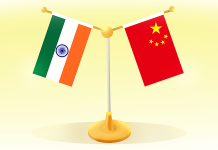
“Ever wonder what happens when a dragon and an elephant share the same stage for 75 years?” As China and India celebrate the milestone of their diplomatic relationship on April 1, 2025, the world watches two ancient civilizations navigate a journey marked by harmony, rivalry, and resilience. From the optimistic chants of ‘Hindi Chini Bhai Bhai’ to the frost of border disputes, this 75-year saga is anything but ordinary. With Presidents Xi Jinping and Droupadi Murmu exchanging warm messages today, the anniversary signals a chance to reset ties—but will it be a graceful duet or a cautious standoff? Buckle up; this isn’t your typical history lesson.
In This Article:
The Big Picture – Why 75 Years Matter
This isn’t just a diplomatic birthday party—it’s a testament to survival. On April 1, 1950, India became the first non-socialist nation to recognize the People’s Republic of China, setting the stage for a relationship that’s shaped Asia’s destiny. Why now? In 2025, both nations are global heavyweights—China’s economic juggernaut meets India’s rising star status. Together, they house 2.7 billion people and drive over 20% of the world’s GDP. But it’s not all about trade stats or border maps; it’s about two cultures that traded silk and Buddhism centuries ago, now wrestling with modern ambitions. “Think of it as a 75-year chess game—sometimes they’re allies, sometimes rivals, but the board’s never empty.”
The Journey Breakdown – Peaks and Valleys
Let’s rewind. The 1950s were golden—Nehru and Zhou Enlai co-authored the Five Principles of Peaceful Coexistence, a.k.a. Panchsheel, dreaming of a borderless brotherhood. Fast forward to 1962, and that dream crashed in the Himalayas with a bitter war over Aksai Chin and Arunachal Pradesh. Relations froze, ambassadors packed up, and the ‘Bhai Bhai’ vibe turned into a long, cold silence. The thaw came slowly—Rajiv Gandhi’s 1988 visit cracked the ice, and by the 2000s, trade boomed, hitting $100 billion by 2018. Then came 2020’s Galwan Valley clash—20 Indian and four Chinese soldiers lost, trust shattered, and apps like TikTok banned. “It’s been a rollercoaster: one minute they’re trading spices, the next they’re trading barbs.”
Flash to 2025: Xi and Murmu’s letters today echo hope. Xi calls it “the right choice” to be partners, while Premier Li Qiang tells Narendra Modi that China’s ready to boost trust and tackle the boundary question. Recent moves—like resuming direct flights and the Kailash Mansarovar Yatra—hint at a diplomatic spring after a four-year winter. But don’t pop the champagne yet; that 2,000-mile Line of Actual Control (LAC) still bristles with troops.
The Geopolitical Stage – Dragons, Elephants, and Eagles
Here’s where it gets spicy. China’s Belt and Road flexes through Pakistan, irking India, while India’s Quad alliance with the U.S., Japan, and Australia rattles Beijing. Myanmar’s a new hotspot—China’s cozying up to the junta, while India plays it neutral, eyeing its Act East ambitions. Then there’s the Brahmaputra dam row—China’s mega-project in Tibet has India and Bangladesh sweating over water security. “It’s not just a two-player game anymore; the U.S. eagle’s circling, and the stakes are global.” Modi’s upcoming U.S. visit in 2025 could tilt the balance, but India’s multi-alignment mantra means it won’t ditch China entirely—economic ties are too juicy.
The Long Game – What’s Next for 75 More?
Picture this: by 2050, could China and India lead a new Asian century? Trade’s already rebounding—$43.3% growth in 2021 despite India’s ‘Make in India’ push. If they sort the LAC mess (75% disengagement’s done, says Jaishankar), we might see joint ventures in tech or climate action. Risks? Plenty. A trade war could dent both economies, and border flare-ups aren’t off the table—60,000 troops per side say so. But optimists point to today’s vibes: Xi’s “Dragon and Elephant Dance” vision meets India’s nod to shared success. “Will it be a blockbuster or a bust? Only time’s got the script.”
The Soul of the Story
China’s my tech lifeline, but India’s my cultural root,” says a Delhi student on X. That’s the heartbeat of this 75-year tale—two nations bound by history, split by geography, yet too big to ignore each other. From Silk Road monks to BRICS summits, it’s a saga of grit and possibility. As Foreign Minister Wang Yi put it in March, “Stable ties serve the Global South.” So, here’s the kicker: can they dance without stepping on toes? “China and India are rolling the dice on 75 more years, and Asia’s holding its breath.”
-By Manoj



